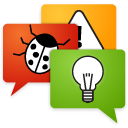
If you filled a bug and got this status as an answer after waiting some time, it can be disappointing. Whether it's Real Software, Apple or some other software vendor.
If I report a bug, I'm never sure whether it is a bug or just my fault. I'm not sure whether it's going to be fixed or not. And if it is fixed, will I get it soon? Will they fix my old version with .1 version update or do I have to wait for the next major update?
With the decision of not fixing the bug, the status is clear. I can now find a workaround or decide myself that I won't fix it. Sometimes I would prefer if the companies answer soon that they won't fix it than if I have to wait years just to get a message that the problem is no longer reproducible.
What do you think?
If you plan to use Filevault 2 in Mac OS X 10.7.2 and you had previously the PGP whole disc encryption installed, you can get intro trouble.
Because as long as PGPwde.kext is in the /System/Library/Extensions folder, your Mac will not boot.
You can of course go in target disc mode and remove the file by mounting the disc on another Mac with Lion.
For me, it's the third time PGP WDE shocked me and certainly the last day it will be allowed to exist on my Macs.
NICKENICH, Germany (October 11th, 2011) -- Monkeybread Software releases version 2.4 of the MBS plug-in for Filemaker.
The MBS plug-in extends Filemaker with over 500 functions. Very popular are our functions for controlling the webview control on your database forms. Other key features working with PDF files, controlling windows, manipulate pictures and to query system informations. In version 2.4 we improve the existing functions and add a few new functions:
- Added new ProgressDialog functions.
- Added Drag and Drop functions for Mac.
- Added USB functions to find and list connected USB devices.
- Added CGPSConverter.Convert function.
- Added String.RemoveNewLine function.
- Added a String.WriteTextFile function.
- Added ShowURL function.
- Added String.ReadTextFile.
- Added Window.Resizable and Window.SetResizable.
- Added Window.ShowsToolbarButton and Window.SetShowsToolbarButton to hide toolbar button on Mac OS X.
- Added String.ReplaceNewline function.
- Added Window.HideScrollbars and Window.ShowScrollbars function.
Read the complete release notes here:
monkeybreadsoftware.de/filemaker/releasenotes.shtml
The plug-in is available for FileMaker 7 to 11 on Windows XP, Vista, 7 and as Universal Binary for Mac OS X. Demos are available on the website, along with license and purchasing information. Not all functions are available on both platforms, so please check the documentation.
The plugins can be downloaded on our website:
monkeybreadsoftware.de/filemaker/
The online documentation can be found here:
monkeybreadsoftware.de/filemaker/reference/
Subscribe to our mailing list to keep up to date:
monkeybreadsoftware.de/filemaker/mailinglist.shtml
For questions you can send us an email or use the feedback forms on our website. Plugin licenses are available starting at just 99 Euro / $149 USD.
This are moments where I think about how much he influenced my life.
Think about where mobile phones would be if Steve didn't start the iPhone project at Apple?
How would laptops look today if Steve didn't push engineers for perfection to get battery life longer or the device thinner.
I wish Apple all the best and I'm confident that Tim Cook and his team will continue to run the company successfully.
see
http://www.apple.com/stevejobs/
Whether you app is made with Real Studio, Filemaker, Xcode or something else, you'll need to learn about sandboxing.
First you can read
Apple's Documentation.
The important thing is to write an entitlement plist file. This can be a text file saved with some text editor (like BBEdit) and saved with extension .plist. Or use the Property List Editor application coming with Xcode.
An entitlement file can look like this:
<?xml version="1.0" encoding="UTF-8"?>
<!DOCTYPE plist PUBLIC "-//Apple//DTD PLIST 1.0//EN" "http://www.apple.com/DTDs/PropertyList-1.0.dtd">
<plist version="1.0">
<dict>
<key>com.apple.security.app-sandbox</key>
<true/>
<key>com.apple.security.files.user-selected.read-write</key>
<true/>
</dict>
</plist>
As you see it's simply an xml file with some special keys and values. Here we turn sandbox on and than define that we want user selected files to be read or written.
Once you have your compiled Carbon or Cocoa application and your entitlement file, you can sign your application. For that you need to name the certificate. If you are Mac Developer, you probably have already a Mac App Store 3rd party developer certificate, so you can use that one. The line goes like this:
codesign -s "certificate name" /path/to/your.app --entitlement yourfile.plist
Now you can run your app on Mac OS X 10.7 and see the sandbox: Yes in the activity monitor application.
It seems like our NSSavePanelMBS class works just fine in sandboxed application. Or do you see an issue?